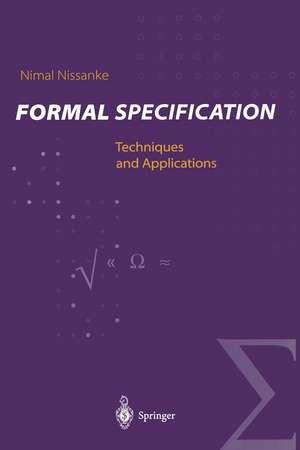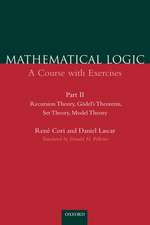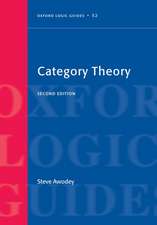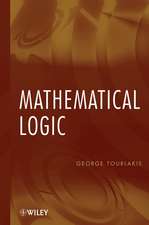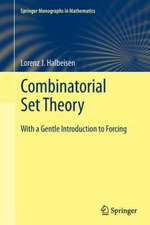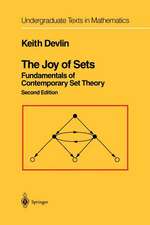Formal Specification: Techniques and Applications
Autor Nimal Nissankeen Limba Engleză Paperback – 27 iul 1999
Preț: 335.03 lei
Preț vechi: 418.79 lei
-20% Nou
Puncte Express: 503
Preț estimativ în valută:
64.11€ • 67.11$ • 53.04£
64.11€ • 67.11$ • 53.04£
Carte tipărită la comandă
Livrare economică 07-21 aprilie
Preluare comenzi: 021 569.72.76
Specificații
ISBN-13: 9781852330026
ISBN-10: 1852330023
Pagini: 316
Ilustrații: XX, 295 p.
Dimensiuni: 155 x 235 x 17 mm
Greutate: 0.49 kg
Ediția:Softcover reprint of the original 1st ed. 1999
Editura: SPRINGER LONDON
Colecția Springer
Locul publicării:London, United Kingdom
ISBN-10: 1852330023
Pagini: 316
Ilustrații: XX, 295 p.
Dimensiuni: 155 x 235 x 17 mm
Greutate: 0.49 kg
Ediția:Softcover reprint of the original 1st ed. 1999
Editura: SPRINGER LONDON
Colecția Springer
Locul publicării:London, United Kingdom
Public țintă
Professional/practitionerCuprins
1. Introduction.- 1.1 Specification and Correctness.- 1.2 Specification as a Contract.- 1.3 Specification as a Design Aid.- 1.4 Specification as a Human Endeavour.- 1.5 Specification as Abstraction.- 1.6 Modularity in Specifications.- 1.7 Benefits Beyond Precision.- 1.8 Formal Specification as an Emerging Technology.- 1.9 Specification Techniques.- 2. Schema Language.- 2.1 Introduction.- 2.2 Type Definitions in Z.- 2.3 Mathematical Definitions in Z.- 2.4 Presentation of Schemas.- 2.5 Schema Manipulation.- 2.6 Significance of Schemas.- 2.7 Some Naming Conventions.- 2.8 Hiding and Projection of Components.- 2.9 Notation for Specification of Systems.- 2.10 Schema Composition.- 2.11 Pre and Post Conditions.- 2.12 Promotion.- Exercises.- 3. An Approach to Specification.- 3.1 Introduction.- 3.2 An Initial Understanding.- 3.3 Abstraction and Modularisation.- 3.4 Flight Journey.- 3.5 Flight Accommodation.- 3.6 Definition of Flight.- 3.7 Operations on Flight.- 3.8 An Airline.- Concluding Remarks.- Exercises.- 4. Specification for Fun.- 4.1 Games as Systems.- 4.2 Musical Chairs.- 4.3 Snakes and Ladders.- Exercises.- 5. A Specification for Clocks.- 5.1 Representation of Time.- 5.2 A Mathematical Definition of Clocks.- 5.3 Clock Utilities.- 5.4 Operations and Transitions.- 5.5 Intervals in Real Time.- Concluding Remarks.- Exercises.- 6. Reasoning About Specifications.- 6.1 Introduction.- 6.2 Kinds of Internal Consistency.- 6.3 Consistency of the General State.- 6.4 Initialisation Consistency.- 6.5 Consistency of Operations.- Exercises.- 7. Specification of a Network Protocol.- 7.1 Introduction.- 7.2 OSI Reference Model.- 7.3 Some Preliminaries.- 7.4 Application Layer.- 7.5 Presentation Layer.- 7.6 Session Layer.- 7.7 Transport Layer.- 7.8 Selected Proofs.- 7.9 Bibliographical Notes.- Exercises.- 8. Object Oriented Specification.- 8.1 Object Orientation in the Narrow Sense.- 8.2 Object Orientation in the Wider Sense.- 8.3 What are Objects?.- 8.4 Some Object Oriented Concepts.- 8.5 Abstract Data Types and Classes.- 8.6 Representation of Classes.- 8.7 Object Oriented Specification Languages.- 8.8 Object Oriented Version of Sequences.- 8.9 Text Processing.- Exercises.- 9. Specification of Safety.- 9.1 Introduction.- 9.2 Specification Framework.- 9.3 Description of System State and Behaviour.- 9.4 System Behaviour in the Presence of Failures.- 9.5 Preventing and Averting Failures.- Concluding Remarks.- Exercises.- 10. An Overview of VDM.- 10.1 Standard Mathematical Notation.- 10.2 Specification of State Based Systems.- 10.3 Composite Objects.- 10.4 Musical Chairs - An Example.- 10.5 An Indexed Filing System — A Case Study.- Exercises.- 11. Algebraic Approach to Specification.- 11.1 Introduction.- 11.2 A Preliminary Comparison.- 11.3 Algebraic Notions.- 11.4 Many—sorted Algebra.- 11.5 Homomorphisms.- 11.6 Term Algebras.- 11.7 Equations.- 11.8 Initial Algebras.- 11.9 Terminal Algebras.- 11.10Bibliographical Notes.- 12. Algebraic Specification in CLEAR.- 12.1 Data Types and Systems.- 12.2 Views of Specifications.- 12.3 An Introduction to CLEAR.- 12.4 A Case Study: A Filing System.- 12.5 Bibliographical Notes.- Exercises.- A. Exercises on Reading Formal Specifications.- A.1 Exercise - A Simple Text Editor.- A.2 Let’s Play A Game of Cards.- A.3 Unix Filing System.- B. Exercises on Writing Formal Specifications.- B.1 A Catalogue Shop.- B.2 Know Your Place if You Succeed in Politics!.- B.3 Traffic Lights.- B.4 A Vending Machine.- B.5 A Bank.- B.6 A Flight Reservation Service for an Airline.- B.7 A Hospital Register.- C. The Mathematical Notation.-References.
